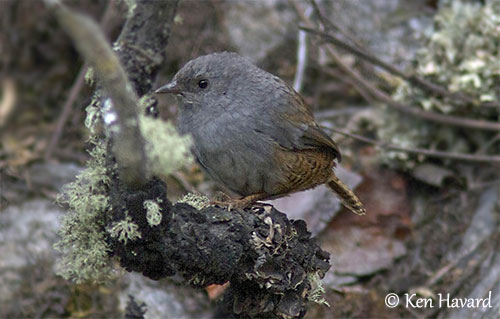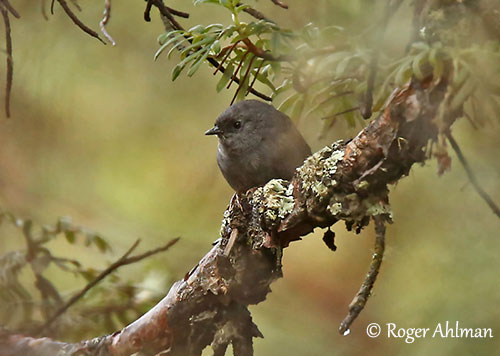
The Ancash Tapaculo usually occurs on or near the ground, and its relatively long legs are well-adapted to this behaviour. The tail is often cocked.
It is often solitary and sometimes in pairs, but it does not join mixed-species groups.
The Ancash Tapaculo is suspected to be socially monogamous. The members of genus Scytalopus are known to be highly territorial and they defend their small area.
The species is sedentary.
It has short, rounded wings and usually flies with difficulty. It only performs short-distance flights. They are poor fliers.
REPRODUCTION OF THIS SPECIES:
The laying occurs in January-February.
Only two nests are known and they are typical of this genus.
The nest is a globular structure made with grass and moss, with a side entrance. It is usually protected and well-hidden among grass tussocks.
The female lays 2-3 white eggs. A juvenile was observed in February.
No more information.
PROTECTION / THREATS / STATUS:
The Ancash Tapaculo is a restricted range species. It is described as uncommon to locally fairly common. Its range at high elevations is protected from human activity, but global climate change may affect this species in the future.
The population is suspected to be stable and the species is not globally threatened.
The Ancash Tapaculo is currently evaluated as Least Concern.
Fr: Mérulaxe affin - Mérulaxe d’Ancash
Ang: Ancash Tapaculo
All: Ancashtapaculo
Esp: Churrín de Ancash
Ita: Tapaculo dell'Ancash
Nd: Ancashtapaculo
Sd: ancashtapakul
Photographers:
Roger Ahlman
Pbase Galleries Peru and Ecuador
Ken Havard
My Bird Gallery & Flickr gallery 1 & Flickr gallery 2
Text by Nicole Bouglouan
Sources:
HANDBOOK OF THE BIRDS OF THE WORLD Vol 8 By Josep del Hoyo-Andrew Elliott-David Christie - Lynx Edicions - ISBN: 8487334504
BIRDS OF SOUTH AMERICA – Passerines - by Robert S. Ridgely and Guy Tudor – HELM Field Guides – ISBN: 9781408113424
BIRDS OF PERU by Thomas S. Schulenberg, Douglas F. Stotz, Daniel F. Lane, John P. O’Neill, Theodore A. Parker III –Princeton University Press 2007– ISBN: 978-0-691-13023-1
Neotropical Birds – Cornell Lab of Ornithology
Fat birder - Rhinocryptidae – Tapaculos
Actualización del rango de distribución del Tapaculo de Ancash (Scytalopus affinis)
Ancash Tapaculo
Scytalopus affinis
Passeriformes Order – Rhinocryptidae Family
INTRODUCTION:
The Ancash Tapaculo is endemic to Peru where it occurs in humid montane forest on the W slope of the Andes, between 3,000 and 4,600 metres of elevation.
This small tapaculo feeds primarily on small invertebrates caught on or near the ground. It nests in a globular structure with a side entrance, well-hidden among the grass tussocks.
The Ancash Tapaculo is uncommon to locally fairly common within its restricted range, but currently, the species is not globally threatened.
DESCRIPTION OF THE BIRD:
Biometrics:
Length: 10-11 cm
Weight: M: 13-15 g – F: 12-12,5 g
The Ancash Tapaculo is a small, usually dull coloured species.
The adult male has pale grey head, mantle, upper back and underparts. Lower back, rump, wings and tail are dark brown. There are narrow dusky bars on tertials, rump and tail.
On the underparts, flanks and undertail-coverts are pale buffy brown with dusky barring.
The head is entirely pale grey.
The thin, pointed bill has blackish upper mandible and mostly greyish lower mandible, with pale flesh base. The eyes are dark brown. Legs and feet are yellow-ochre, but the tarsi are darker at rear.

The female resembles male but she has more rufous tinge and more extensive brown colour above.
The juvenile has grey crown and mantle, slightly washed brownish. Rest of upperparts are pale olive-brown, but entire upperparts are barred dark.
The underparts are pale grey, but flanks and undertail-coverts are pale olive-brown. Body sides, flanks and undertail-coverts show dark barring.
RANGE:
The Ancash Tapaculo occurs in the Department of Ancash in the Cordillera Blanca, in W Andes of Peru.
The range has been extended to the north (central La Libertad), the east (W Huánuco) and the south (N Lima).
HABITAT:
The Ancash Tapaculo is found at high elevation, between 3,000 and 4,600 metres of elevation. It frequents undergrowth of Polylepis woodland patches and shrubs, and adjacent grassy and rocky areas.
CALLS AND SONGS: SOUNDS BY XENO-CANTO
The Ancash Tapaculo utters a short, descending “churr” usually repeated for long periods of up to 30 seconds or more.
Another aggressive song is a series of short, fast (20 notes/second), dry rattle “trrrrr…trrrrr…trrrrr…”
BEHAVIOUR IN THE WILD:
The Ancash Tapaculo feeds on small insects and probably seeds and soft plant material too.
It forages on or near the ground, moving in mouse-like action among rocks and grass tussocks. It also forages in Polylepis and Gynoxys trees, searching for prey along the mossy branches.
